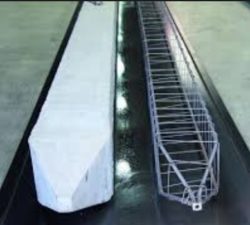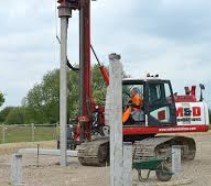Considering that we made the decision early on to have a concrete house we have to take into account the extra weight of the whole structure. The “soil” (sandy marine clay and rock fragment) we will be building on is probably fill the developer threw on top of a marsh to create “dry” land and from the surrounding canals.
Considering the average elevation of the lot is +3.5 feet above sea level, you can bet the foundation will be sitting in salt water.
The current method is to drive precast concrete piers into the existing soil “driven to refusal”. That means a pile driver will hit the pier into the soil until there is enough compacted material to stop the the pier from going farther.
Across the tops of the driven piers, lie the grade beams. Theses are 16″ x 16″ horizontal concrete beams that carry and distribute the weight of the house structure on to the piers.
Above that is a 6″ concrete slab with a waterproof plastic mat under it.
One of the issues I am researching is “can the concrete for the piers be made with fly ash or Type V concrete”? This concrete mix does not react to salt water as regular concrete does. The fly ash is created from coal fired electric-producing plants as a byproduct. The ancient Romans used the fly ash from volcanos for their concrete mix.
A beneficial result of fly ash is helps prevent spalling. Spalling is the reaction to salts in concrete that causes a chemical reaction. The chemical reaction causes expansion of the material and corrosion for the rebar. The result is weakened concrete.
Another efficient way of controlling temperature and sulfate attack is through the use of pozzolans and slag that have become widely available. Portland pozzolana cement is produced either by grinding together, Portland cement clinkers and pozzolana with the addition of gypsum or calcium sulfate or by intimately and uniformly blending Portland cement and fine pozzolana.
Another way to prevent spalling is to use coated steel rebar. The rebar can be galvanized with zinc to coat it against corrosion. The zinc will corrode before the steel. There is rebar coated with a plastic but I am unsure if any of these are cost effective for a small residence. There is composite rebar which is made from glass fiber reinforced polymer. It is rust proof, which would be great in a marine environment. It’s limitations preclude it from being used in a small project. It cannot be bent in the field or shaped with heat. In residential construction, where bending of rebar is the norm, composite rebar won’t be used.
For precast concrete products, with a specialized need, this product, in a marine environment sounds great. I am going to research if “green” (coated rebar) and the better Portland pozzolana cement is used for house piers in areas of high water tables in a marine environment.
In a foundation, corrosion and spalling can be costly to fix, if even possible. Cost is always a factor in construction too. Any ideas of these newer types of construction draws concerns from contractors.



8 comments
Хорошая статья
Thank you. Unfortunately the death of the designer and finding another designer has been difficult. I hope to restart this spring.
I just started my blog a few months ago and discovered this site just two weeks now, and wow…So grateful for you. Thanks for the post. awesome.. Dorothee Mano Maxy
Thanks for the reminder. I did this just to keep busy and never thought it would be this extensive. I did not keep any records of the source of images. As this is not a site for making money, I assumed it was OK to use. If you know the owner’s of the images please let me know.
We’re doing ICF in the Keys as well, directly on the ocean, with background in both engineering and construction and prior experience in South Florida.
If you ever want to compare notes or exchange ideas, references for subs, etc — happy to collaborate with you.
I want to apologize for not contacting you sooner. I have not been using my site as I have been inundated with bad news.
The ICF plans we had came in at +$900,000 and that was way more than our dry lot was worth carrying.
My original designer did not tell me he had heart disease and he died during the process. His boss was a thief, and stole more money and did not deliver the work. The next design/build guy came in at $650k and after his engineer got done the cost was $1 million!!!! Not going to happen…..
So I’ve lost 3 years in Marathon’s BPAS process due to this stuff. I am waiting for the City Council’s March 2021 decision. So we went with block, metal roof with the carport at +8.01 feet. It’s the best we can do, considering…..
After all that, with inflation due to Covid and past hurricane issues we have come close to getting our permit and hopefully starting construction. But the cost has risen to almost the cost I was quoted for ICF (a few years ago). I can’t seem to win at this game. I just hope I have enough sanity left to enjoy the Keys when this is all done!
Good luck on your project!
Were you given a round number per square foot for an ICF house? Everyone we spoke with ended up giving us the same dollar amount estimate for our construction amount. I was curious if that was standard practice?
This design is steller! You definitely know how to keep a reader entertained.
Between your wit and your videos, I was almost moved to start my own blog (well, almost…HaHa!) Excellent job.
I really enjoyed what you had to say, and more than that,
how you presented it. Too cool!